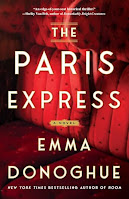Widely admired author Emma Donoghue manages to capture some version of fin de siècle zeitgeist while also spinning a suspenseful action narrative in The Paris Express. She sets her scene in an actual 1895 out-of-control express train that crashes into the Montparnasse station, and assembles within it a cast of historical figures, (some of whom were actually passengers on the wreck). This clever device gathers together key figures who represent the coming train wreck that is the 20th Century. It’s a bravura performance; I recommend it for its intelligence, its respect for its readers, and not least for its breathless pacing.
A national railway express leaves Granville on the Normandy coast bound for Paris, and its passengers include a handful of deputies, or representatives, of the Orne Department of France. The author also calls “all aboard” to scientists, prominent engineers and captains of industry, and literary and artistic lights of the period, and a very angry young anarchist with a bomb. Donoghue names and clearly identifies these souls in the novel. The author mounts an elaborate, nail-biting race against death, in a highly diverting, and very well-organized novel.
And the interaction of these disparate characters, along with the threat to everyone’s life, along with the speed of the action, all make for a very rewarding, heart-quickening experience. This mélange represents for me the headlong speed and power of wrenching change the world will suffer as the 19th Century swings along into the 20th. For on this train is a French automotive pioneer and industrialist Émile Lavassor; Irish dramatist John Millington Synge; Max Jacob, the French poet and painter; Henry Tanner, the African-American painter; and Marcelle Lapicque, a neurophysiologist who lived until 1960. This is not an exhaustive list, but it illustrates the grand scope of Donoghue’s story, in that it brings all these characters into play. The momentum, the dreadnaught, irresistible forces in play, would wreck any static edifice in its way, be it Montparnasse station, or any settled, backward-looking lassitude. I was quite out of breath at the end of this book.
The author shows a steely discipline as she yolks her wildly divergent elements into a cohesive, yet breakneck, story. It’s very well done.


















No comments
Post a Comment